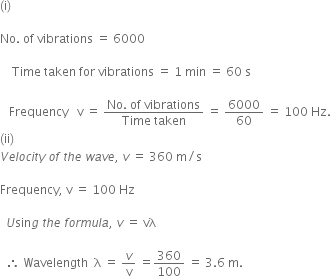A body is vibrating 6000 times in one minute. If the velocity of sound in air is 360 m/s, find
(i) frequency of vibration in Hz, and
(ii) wavelength of the wave produced.

A body is vibrating 6000 times in one minute. If the velocity of sound in air is 360 m/s, find
(i) frequency of vibration in Hz, and
(ii) wavelength of the wave produced.

Write the steps you would use for making tea. Use the words—solution, solvent, solute, dissolve, soluble, insoluble, filtrate and residue.
Pragya tested the solubility of three different substances at different temperatures and collected the data as given below (results are given in the following table, as grams of substance dissolved in 100 grams of water to form a saturated solution).
|
Substance Dissolved |
Temperature in K |
||||
|
283 |
293 |
313 |
333 |
353 |
|
|
Potassium nitrate |
21 |
32 |
62 |
106 |
107 |
|
Sodium chloride |
36 |
36 |
36 |
37 |
37 |
|
Potassium chloride |
35 |
35 |
40 |
46 |
54 |
|
Ammonium chloride |
24 |
37 |
41 |
55 |
66 |
Pragya makes a saturated solution of potassium chloride in water at 353 K and leaves the solution to cool at room temperature. What would she observe as the solution cools? Explain.
|
Substance Dissolved |
Temperature in K |
||||
|
283 |
293 |
313 |
333 |
353 |
|
|
Potassium nitrate |
21 |
32 |
62 |
106 |
107 |
|
Sodium chloride |
36 |
36 |
36 |
37 |
37 |
|
Potassium chloride |
35 |
35 |
40 |
46 |
54 |
|
Ammonium chloride |
24 |
37 |
41 |
55 |
66 |
Find the solubility of each salt at 293 K. Which salt has the highest solubility at this temperature?
|
Substance Dissolved |
Temperature in K |
||||
|
283 |
293 |
313 |
333 |
353 |
|
|
Potassium nitrate |
21 |
32 |
62 |
106 |
107 |
|
Sodium chloride |
36 |
36 |
36 |
37 |
37 |
|
Potassium chloride |
35 |
35 |
40 |
46 |
54 |
|
Ammonium chloride |
24 |
37 |
41 |
55 |
66 |
Pragya tested the solubility of three different substances at different temperatures and collected the data as given below (results are given in the following table, as grams of substance dissolved in 100 grams of water to form a saturated solution).
|
Substance Dissolved |
Temperature in K |
||||
|
283 |
293 |
313 |
333 |
353 |
|
|
Potassium nitrate |
21 |
32 |
62 |
106 |
107 |
|
Sodium chloride |
36 |
36 |
36 |
37 |
37 |
|
Potassium chloride |
35 |
35 |
40 |
46 |
54 |
|
Ammonium chloride |
24 |
37 |
41 |
55 |
66 |
Explain the following giving examples:
Saturated solution
Explain the following giving examples:
Pure substance
Mock Test Series